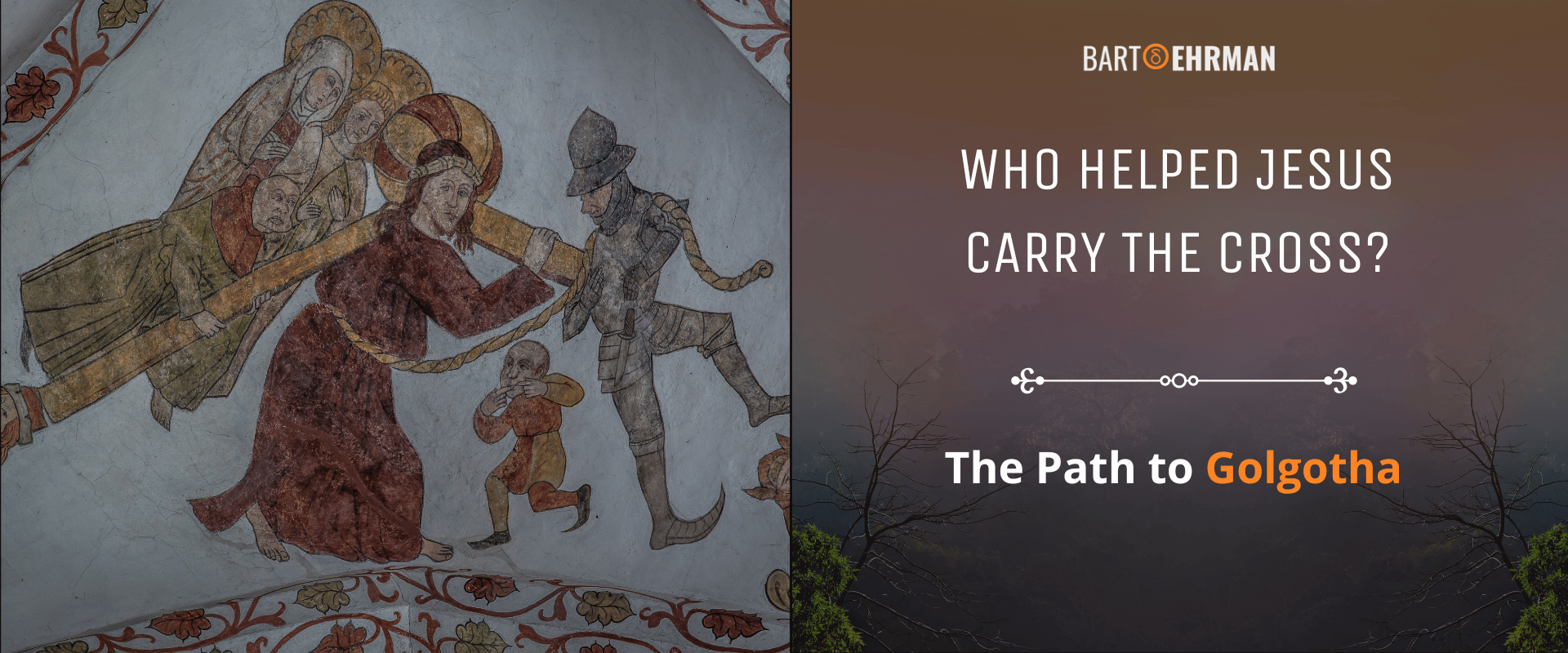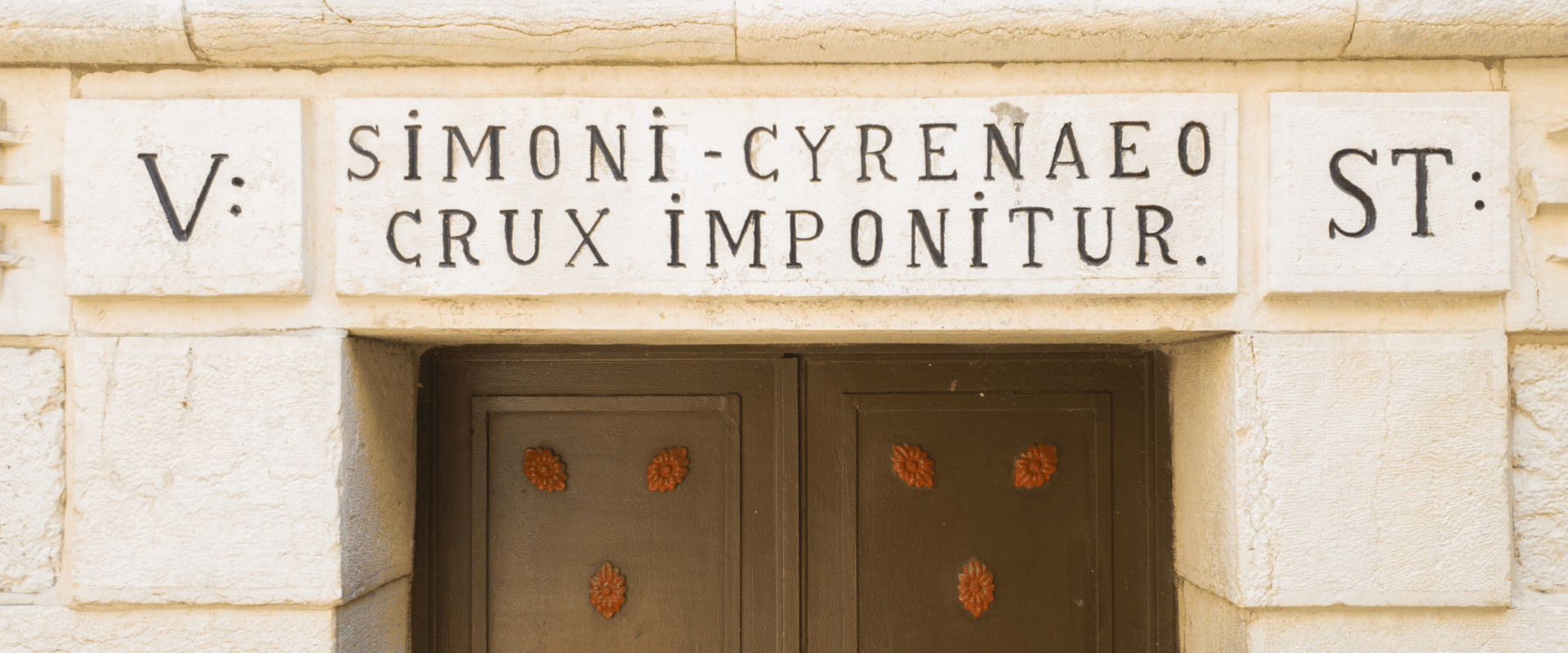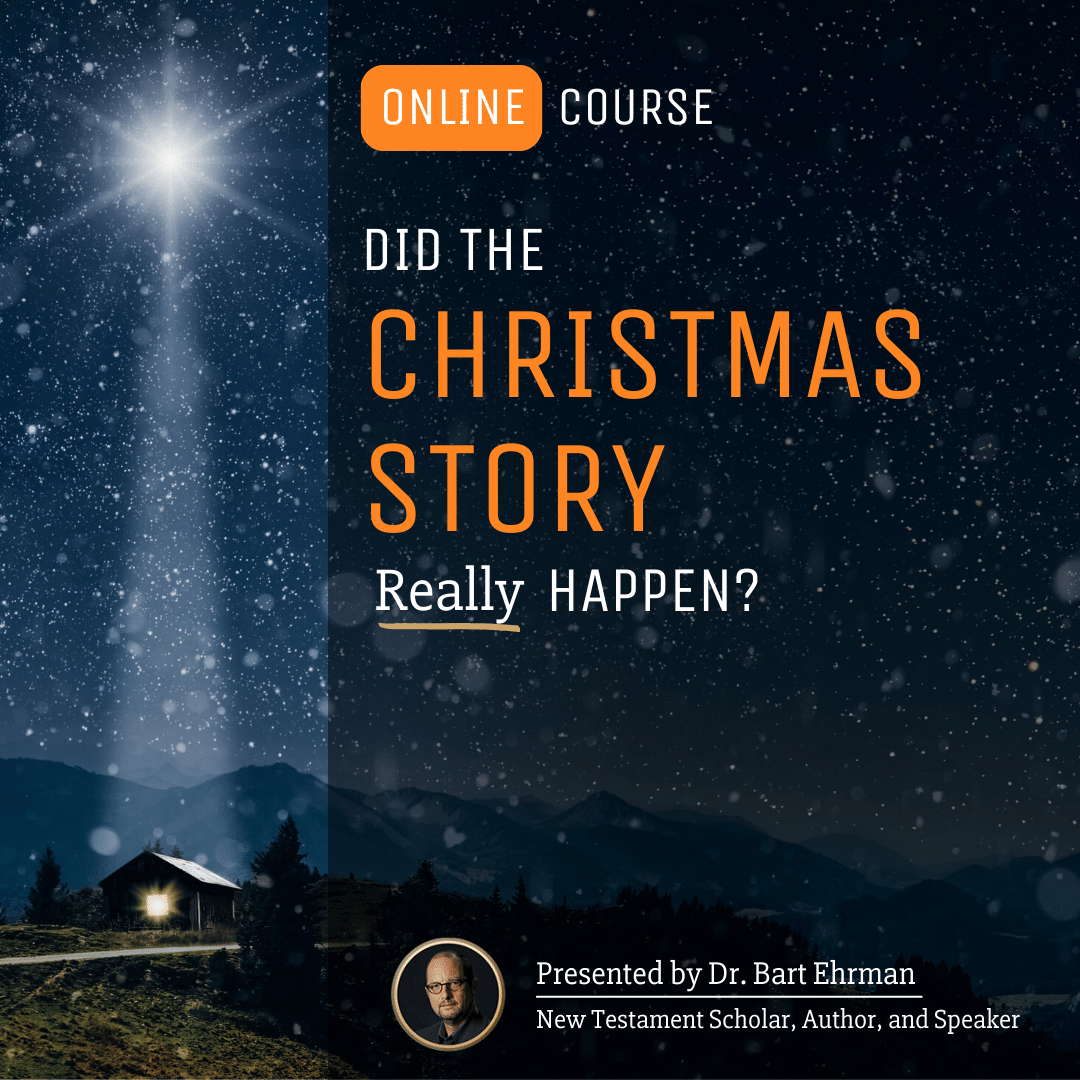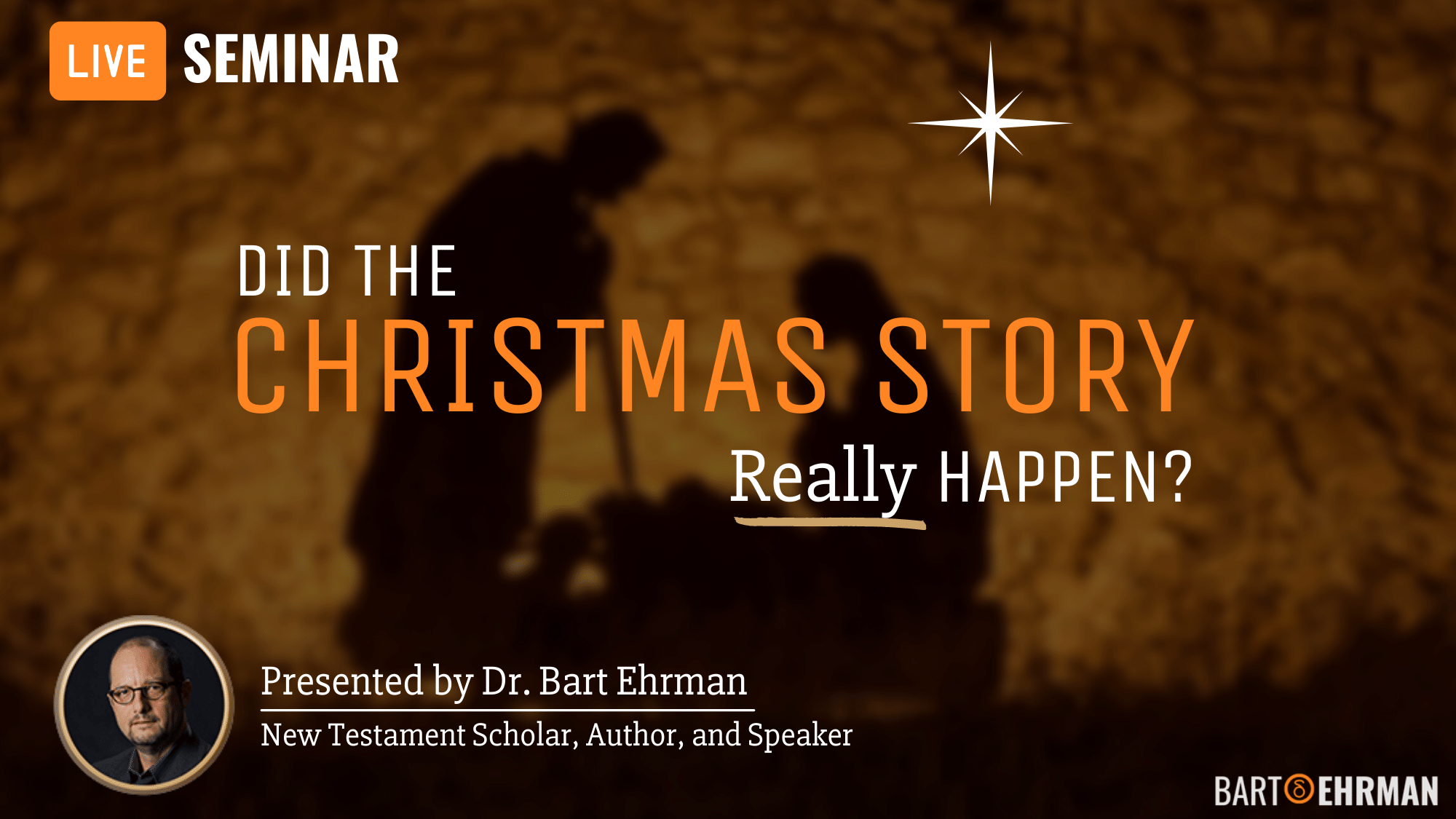Who Helped Jesus Carry the Cross? The Path to GolgOtha

Written by Marko Marina, Ph.D.
Author | Historian
Author | Historian | BE Contributor
Verified! See our guidelines
Verified! See our editorial guidelines
Date written: February 10th, 2024
Disclaimer: The views and opinions expressed in this article belong to the author and do not necessarily match my own. - Dr. Bart D. Ehrman
In Mel Gibson's 2004 film, "The Passion of the Christ," a poignant scene captures the forced involvement of Simon of Cyrene in Jesus' journey to Golgotha. As Simon, compelled by Roman soldiers, begins to bear the weight of the cross, he declares to the onlookers, “I’m an innocent man forced to carry the cross of the condemned man.”
This cinematic portrayal, while emotionally charged, brings to the forefront a historical query that has intrigued scholars and theologians alike: Who helped Jesus carry the cross?
This seemingly straightforward question unravels layers of historical, textual, and theological complexities. The narrative of Jesus' path to crucifixion, as we’ll see, isn’t uniformly recounted across the Gospels.
As a historian examining this pivotal moment in the Christian tradition, the goal isn’t to reconcile these narratives into a singular, harmonized account. Instead, it’s to explore and understand the varied portrayals and their implications within the historical framework of early Christianity.
This article dissects these narratives, considering the historical practice of crucifixion in the Roman world, the textual differences among the Gospel accounts, and the possible reasons behind these discrepancies. Through this scholarly discourse, we seek to illuminate how this question of who helped Jesus carry the cross enhances our understanding of the historical Jesus and the early Christian movement.

Crucifixion in the Ancient World
While the crucifixion remains indelibly associated with the narrative of Jesus' death, its historical roots and implications extend far beyond the confines of first-century Judea. The practice of crucifixion, as a form of state-sanctioned execution, was a prevalent method of capital punishment in the ancient world, particularly within the Roman Empire.
This brutal method of execution was not unique to the Romans; it had been employed by various ancient civilizations, including the Assyrians and Carthaginians, as a means of asserting control and instilling fear among subjugated populations.
The Romans, however, perfected crucifixion as a tool of deterrence and domination. It was designed not only to inflict maximum physical pain but also to serve as a powerful public spectacle of shame and subjugation. The crucified were often displayed in prominent locations, such as along busy roads or at city gates, as stark warnings to any who might challenge Roman authority.
In the context of Jesus' crucifixion, the method takes on additional layers of significance. The Gospels' accounts of Jesus carrying his cross through the streets of Jerusalem to Golgotha reflect a historical practice where the condemned were often forced to bear their cross to the site of their execution.
This procession wasn’t merely a part of the punishment but also a ritualistic humiliation, a final journey marked by public scorn and abuse - so vividly described in Gibson’s movie. Within this solemn march, a question arises: "How far did Jesus carry the cross?"
Scholars estimate the distance from the place of sentencing to Golgotha was approximately half a mile - a path laden with the physical weight that illustrates the depth of Jesus’ suffering.
Understanding crucifixion in its historical and cultural context is crucial for comprehending the narratives of Jesus' final journey in the Gospels. It highlights the intersection of Roman judicial practice with the theological symbolism embraced by early Christian communities.
As we delve into the differing Gospel accounts of this journey, this backdrop of Roman crucifixion practices provides a foundational lens through which to examine and interpret these texts.
Who Helped Jesus Carry the Cross? Synoptic Tradition
Before delving into the disparate accounts of Jesus' path to Golgotha, it’s crucial to acknowledge the physical condition of Jesus as depicted in the Gospels. Following a series of brutal beatings that left Him severely weakened, the question of "How far did Jesus carry the cross?" becomes not only a matter of distance but of profound historical significance.
The Synoptic Gospels—Mark, Matthew, and Luke—offer varied insights into this journey, each contributing unique perspectives to the narrative. In Mark's Gospel, Jesus is portrayed with a sense of vulnerability and near silence throughout His ordeal, providing sparse commentary on His fate.
Bart D. Ehrman notes that this depiction starkly contrasts with Luke's account, where Jesus appears more committed and even takes a moment to address the daughters of Jerusalem, offering them words of comfort and prophecy.
Of particular note is the role of Simon of Cyrene, who is introduced in Mark’s account as the one who helped Jesus carry the cross. Contrary to popular cinematic depictions, such as those seen in "The Passion of the Christ," Mark doesn’t describe Jesus as initially carrying the cross and then stumbling, necessitating Simon's intervention.
Instead, Simon is compelled by the Romans to take up the cross from the outset. This detail, though seemingly minor, has significant implications for understanding the historical and theological context of Jesus’ crucifixion. It reflects the Roman practice of humiliating the condemned and the community's involvement in the process, either as spectators or, unwillingly, as participants.
The portrayal of Simon of Cyrene's involvement is crucial for understanding the broader narrative of the crucifixion. It raises the question of who helped Jesus carry the cross, a query that not only interests historical and theological scholars but also resonates with readers seeking a deeper understanding of the Passion narrative's complexities.
In summary, the Synoptic Gospels present a layered and complex portrayal of Jesus' path to crucifixion, marked by physical suffering, moments of interaction, and the significant act of Simon of Cyrene carrying the cross.
Who Helped Jesus Carry the Cross in the Gospel of John?
The Gospel of John presents a narrative of Jesus' path to the cross that markedly diverges from the accounts found in the Synoptic Gospels. Unlike the Synoptics, where Simon of Cyrene is compelled to assist Jesus with the cross, John emphatically states that Jesus carried His cross the entire way to Golgotha.
This depiction in John 19:17 underscores a theological emphasis on Jesus’ sovereignty and purpose in His suffering and death, portraying Him as fully in control of the events leading to His crucifixion.
John’s depiction of Jesus who carries the cross alone not only emphasizes his strength in the face of suffering but also sets the stage for a common image in the Christian tradition: Jesus beginning His journey with the cross, stumbling under its weight, and then being aided by Simon of Cyrene.
Did You Know?
Some Gnostic Christians hold a fascinating view of the crucifixion narrative. They suggest that using his powers of transfiguration, Jesus switched appearances with Simon of Cyrene, the man forced to help carry the cross. According to this intriguing belief, it was Simon who was mistakenly crucified in Jesus' stead, a twist that challenges conventional interpretations and showcases the diverse early Christian perspectives on Jesus' final moments.
This image, prevalent in many artistic and cinematic representations, arises from attempts to harmonize the account in Mark, where Simon of Cyrene is compelled to carry the cross, with John's depiction of a Jesus who bears His cross alone from the outset.
The endeavor to reconcile John's narrative with the Synoptic Gospels highlights the complexity and depth of the Gospel accounts. It underscores the challenge of constructing a cohesive picture of Jesus' path to Golgotha.
For readers interested in exploring these differences further, Bart D. Ehrman's study "Jesus Interrupted" provides an insightful examination of the contradictions within the canonical Gospels, offering a window into the early Christian communities from a scholarly perspective.
What Can We Know About Simon of Cyrene?
Simon emerges in the Gospel narratives as a figure momentarily thrust into the profound drama of Jesus' path to crucifixion. According to Mark’s Gospel, he is the person who carried Jesus’ cross. But what happened to Simon of Cyrene after the crucifixion?
As it turns out, beyond this pivotal role, details about his life remain largely enigmatic. Cyrene, a city located in what is modern-day Libya, was home to a significant Jewish population, suggesting Simon was likely in Jerusalem to observe Passover, a detail that provides only a glimpse into his possible religious and cultural background.
Moreover, an intriguing element in Mark could, according to some scholars, offer a slender thread to understanding more about Simon and the possible origins of his story in the Gospels. Unlike Matthew and Luke, Mark mentions Simon’s sons Alexander and Rufus.
Richard Bauckham has speculated on this mention, suggesting that it signals to Mark’s readers the real source of the story about Jesus’ path to Golgotha and Simon of Cyrene. Bauckham notes: “There doesn’t seem to be a good reason available other than that Mark is appealing to Simon’s eyewitness testimony, known in the early Christian movement not from his firsthand account but through his sons.”
Despite the appeal of Bauckham's argument for some, it raises questions when juxtaposed against the broader context of Gospel narratives and their transmission. The reliance on such a specific inference doesn’t fully address the contradictions found within the Gospels, nor does it align comfortably with what is understood about the fluid nature of oral tradition in early Christian communities.
This discussion leads us to a broader examination of the discrepancies between the Gospels, particularly between Mark's account, where Simon of Cyrene is depicted as carrying Jesus' cross, and John's narrative, which asserts that Jesus bore the cross alone.
Who Helped Jesus Carry the Cross? Understanding Contradictions
Stories of Jesus’ path to Golgotha were, as Raymond Brown noted long ago, among the earliest narratives circulated within diverse communities across the Mediterranean. With the first Gospel, Mark, penned approximately 40 years after Jesus' death and the last one, John, written some 65 years later, the interim was marked by an oral tradition that served as the primary means of transmission.
Cultural anthropologists like Jan Vansina have highlighted that in oral cultures, stories are not static; they evolve with each retelling, with slight alterations in the narrative emerging each time a story is passed on. This dynamic nature of oral storytelling ensures that the narratives are imbued with the values, interpretations, and theological insights of the communities that preserve and share them.
This process of narrative evolution of the Gospels is crucial for understanding the discrepancies such as who helped Jesus carry the cross. To learn more about it, I invite you to read an excellent study by Dr. Bart D. Ehrman “Jesus Before the Gospels”.
Furthermore, each Evangelist approached the story of Jesus' Passion from a distinct theological perspective, shaped by the needs and understandings of their respective communities. For instance, Mark's Gospel, with its emphasis on Simon of Cyrene's role, reflects a particular interest in highlighting themes of discipleship and bearing one's cross.
In contrast, John's narrative, which depicts Jesus carrying the cross alone, underscores the sovereignty and enduring strength of Christ in the face of suffering.
These variations are not merely editorial choices but are deeply rooted in the theological agendas and communal identities of the early Christian writers. The discrepancies between the Gospels on the question of "Who Helped Jesus Carry the Cross?" thus emerge as a natural outcome of the oral tradition's inherent fluidity and the Evangelists' theological intentions.
Given the significant time gap between Jesus' death and the writing of the Gospels, coupled with the oral culture's propensity for narrative adaptation, it becomes challenging to ascertain the precise historical details of these events.
Consequently, while the question of who exactly helped Jesus or if he bore the cross alone invites intriguing scholarly exploration, definitive answers remain elusive due to the scant early evidence and the complex interplay of oral tradition and theological reflection.
Nonetheless, if pressed to speculate based on the available evidence and the nuances of early Christian oral traditions, I would lean towards an earlier (Mark's) account, making an informed conjecture that Simon of Cyrene indeed played a role in assisting Jesus with the cross.

The Enduring Legacy of Simon of Cyrene and His Family
Despite the brevity of his mention in the Gospels, early Christian communities wove elaborate stories around Simon, attributing to him and his family a significant role in the burgeoning Christian movement. These post-crucifixion traditions suggest that Simon's encounter with Jesus was transformative, marking the beginning of a deep and enduring faith.
Legends hold that Simon, along with his sons Alexander and Rufus, became prominent figures in the early Church. The mention of Rufus in Romans 16:13 by Paul, "Greet Rufus, chosen in the Lord, and his mother, who has been a mother to me, too," has been interpreted in the Christian tradition as a reference to the same Rufus, son of Simon.
This connection, though speculative, illustrates the attempts by early Christians to weave the lives of Gospel figures into the broader narrative of the Church's foundation, highlighting the interconnectedness of these early believers.
Moreover, in Christian art and thought, Simon's act of helping Jesus carry the cross on his path to Golgotha has been celebrated as an exemplar of unwitting service to Christ.
Byzantine and medieval art frequently depict Simon in the act of carrying the cross, symbolizing the burden of Christian faith borne with humility and grace. One such example is found in the Church of the Holy Saviour in Chora (now the Kariye Museum) in Istanbul, Turkey. This mosaic, dating back to the early 14th century, is part of a series that illustrates the life and passion of Christ.
It vividly portrays Simon of Cyrene, identified by inscriptions, stepping in to bear the weight of the cross behind Jesus, encapsulating the theme of shared suffering and assistance in the Christian narrative.
This visual motif has served as a powerful reminder of the Christian call to bear one's cross, drawing a direct line from Simon's act of compelled assistance to the voluntary acceptance of hardship in the name of faith.
The legacy of Simon of Cyrene, as preserved through centuries of Christian tradition and art, highlights the profound impact of momentary encounters with the divine. It reflects a communal desire to find meaning and connection in the peripheral figures of the Gospels, elevating them to models of faith and devotion.
The evolution of Simon of Cyrene from an unwitting participant, conscripted by Roman soldiers into the narrative of the Passion, to a revered symbol of faith and devotion in Christian tradition and art, is a fascinating story of “spiritual promotion”. This metamorphosis suggests that in the ecclesiastical draft of history, even those who are drafted can become draftsmen of faith, drawing a line of devotion through the ages.
The Cross, Jesus and Simon of Cyrene: Summing up Conclusions
In tracing the path to Golgotha, a journey marked by suffering and profound symbolism, the question of "Who helped Jesus carry the cross?" has led us through a labyrinth of historical, textual, and cultural exploration.
This inquiry, ignited by the vivid scenes of Simon of Cyrene's forced yet transformative participation in the Passion narrative as depicted in Mel Gibson’s “Passion of the Christ”, underscores the complexities inherent in piecing together the mosaic of early Christian narratives.
Despite the disparate accounts within the canonical Gospels and the additional layers of tradition and legend that have adorned the story over centuries, the enduring image of Simon assisting Jesus remains a powerful symbol of faith, humility, and human interconnectedness in the shadow of divine purpose.
This exploration into the narratives and legends surrounding the crucifixion and Simon of Cyrene's role invites us to reflect on the broader questions of authorship, tradition, and the transmission of the Gospels.
For those intrigued by these complexities and seeking deeper insights into the origins of the Gospel narratives, Dr. Bart D. Ehrman offers an enlightening online course titled "Did Matthew, Mark, Luke, and John Actually Write Matthew, Mark, Luke, and John?"
This course delves into the fascinating debates surrounding the authorship of the Gospels, providing learners with a scholarly yet accessible examination of the evidence and arguments that continue to shape our understanding of these foundational texts.


